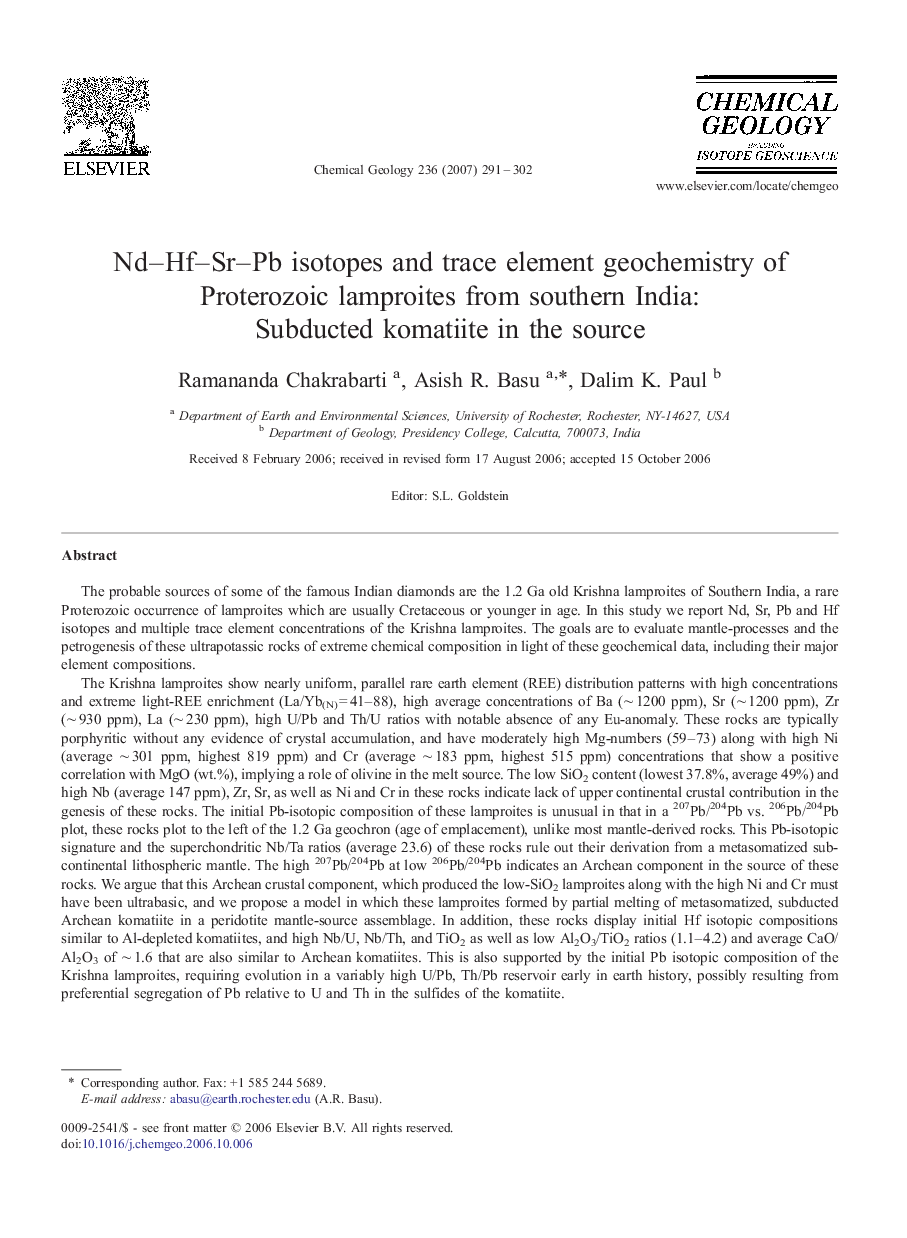| کد مقاله | کد نشریه | سال انتشار | مقاله انگلیسی | نسخه تمام متن |
|---|---|---|---|---|
| 4701166 | 1637757 | 2007 | 12 صفحه PDF | دانلود رایگان |

The probable sources of some of the famous Indian diamonds are the 1.2 Ga old Krishna lamproites of Southern India, a rare Proterozoic occurrence of lamproites which are usually Cretaceous or younger in age. In this study we report Nd, Sr, Pb and Hf isotopes and multiple trace element concentrations of the Krishna lamproites. The goals are to evaluate mantle-processes and the petrogenesis of these ultrapotassic rocks of extreme chemical composition in light of these geochemical data, including their major element compositions.The Krishna lamproites show nearly uniform, parallel rare earth element (REE) distribution patterns with high concentrations and extreme light-REE enrichment (La/Yb(N) = 41–88), high average concentrations of Ba (∼ 1200 ppm), Sr (∼ 1200 ppm), Zr (∼ 930 ppm), La (∼ 230 ppm), high U/Pb and Th/U ratios with notable absence of any Eu-anomaly. These rocks are typically porphyritic without any evidence of crystal accumulation, and have moderately high Mg-numbers (59–73) along with high Ni (average ∼ 301 ppm, highest 819 ppm) and Cr (average ∼ 183 ppm, highest 515 ppm) concentrations that show a positive correlation with MgO (wt.%), implying a role of olivine in the melt source. The low SiO2 content (lowest 37.8%, average 49%) and high Nb (average 147 ppm), Zr, Sr, as well as Ni and Cr in these rocks indicate lack of upper continental crustal contribution in the genesis of these rocks. The initial Pb-isotopic composition of these lamproites is unusual in that in a 207Pb/204Pb vs. 206Pb/204Pb plot, these rocks plot to the left of the 1.2 Ga geochron (age of emplacement), unlike most mantle-derived rocks. This Pb-isotopic signature and the superchondritic Nb/Ta ratios (average 23.6) of these rocks rule out their derivation from a metasomatized sub-continental lithospheric mantle. The high 207Pb/204Pb at low 206Pb/204Pb indicates an Archean component in the source of these rocks. We argue that this Archean crustal component, which produced the low-SiO2 lamproites along with the high Ni and Cr must have been ultrabasic, and we propose a model in which these lamproites formed by partial melting of metasomatized, subducted Archean komatiite in a peridotite mantle-source assemblage. In addition, these rocks display initial Hf isotopic compositions similar to Al-depleted komatiites, and high Nb/U, Nb/Th, and TiO2 as well as low Al2O3/TiO2 ratios (1.1–4.2) and average CaO/Al2O3 of ∼ 1.6 that are also similar to Archean komatiites. This is also supported by the initial Pb isotopic composition of the Krishna lamproites, requiring evolution in a variably high U/Pb, Th/Pb reservoir early in earth history, possibly resulting from preferential segregation of Pb relative to U and Th in the sulfides of the komatiite.The Al-depleted subducted komatiitic component was enriched by carbonate metasomatism in the peridotitic mantle. This metasomatism was responsible for the observed Nd–Hf isotope characteristics, specifically variable εNd(T) at relatively constant εHf(T) in the lamproites. This Nd–Hf-isotopic characteristic seems to be common in global lamproites of all ages. Our proposed model for the genesis of the Krishna lamproites involving a subducted komatiitic source may also be applicable for other global lamproites from cratonic settings, as older komatiite-bearing subducted crustal components were possibly ubiquitous in the architecture of ancient cratonic mantle.
Journal: Chemical Geology - Volume 236, Issues 3–4, 30 January 2007, Pages 291–302